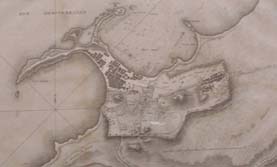RESEARCH PROJECT
. Alexandria, a port city in the Ottoman era
Alexandria, Ottoman port city
Research project, Alexandria Aix-en-Provence
By Michel Tuchscherer, project coordinator, lecturer University of Provence, IREMAM
From the 16th to the beginning of the 19th centuries, Alexandria was one of the most active ports of the Mediterranean sea. Every year hundreds of vessels connected it with not only the many ports of the vast Ottoman Empire - Istanbul, Thessalonika, Izmir, Chania, Beirut, Tunis to mention just a few - but also with Venice, Ragusa, Ancona and Marseilles. In the year 1521, the sultan Suliman the Magnificent, in a document still little known(1), granted a first Capitulation to the merchants of Marseilles. The privileges accorded allowed them to swiftly establish a lasting and particularly eminent position in the trade relations between Ottoman Egypt and Europe.
Despite the important role of Alexandria in the eastern Mediterranean basin of the Ottoman era and despite the close relations with Europe and particularly Provence, the history of the city at this period remains somewhat neglected.
However, at that time, this Mediterranean city was experiencing considerable transformations. In the 15th century the ancient site of the town was progressively abandoned in favour of the peninsula which connected the city to the ancient lighthouse. The Ottomans continued this shift to the extent that three centuries later the antique city was little more than a vast field of ruins while a new town was growing up on the spit of land leading to the ancient Pharos.
On the other hand, the strengthening of commercial relations between Alexandria and Europe from the beginning of the reign of Mohamed Ali gave impetus to a new expansion, which manifested itself in a further shift of the city. The ancient site was rebuilt thus protecting the so-called Turkish Town from irremediable changes.
In order to reconstruct this neglected but prestigious past the historian has recourse to quite exceptional sources. First of all these are the diverse archival resources of Egypt, and also those of all the Mediterranean towns that maintained privileged relations with Alexandria. The biggest consists of some 120 records of the Ottoman tribunal at Alexandria, the oldest documents of which date back to 957/1550 (more than 120,000 documents). These are held in the National Archives at Cairo. The archives of Istanbul, Dubrovnik, Venice, Tunis, Algiers and Marseilles also contain an important part of this history.

Other than this archival material, the site as well as ancient and modern cartography provide another fundamental data base. If a great number of Ottoman era buildings have now disappeared, the road network and the fabric of construction lots have largely been preserved in what is still known as the Turkish Town.
The research project follows four principal themes: the urban setting, the economy, institutions and society.
Last year, a team of researchers belonging to universities and academic institutions from all sides of the Mediterranean - Egyptian, Turkish, Tunisian, Italian, Algerian, and French - began an investigation of the documentary resources.
A first Mediterranean round-table will be held in Alexandria in 2002 in preparation for an international colloquium in 2003.
(1) An Arabic text of this document is held in the archives of the Yonne Department, France. This document and translation will soon be published.
Presentation of the research project
The research project on the town of Alexandria in the Ottoman era is based upon a partnership between four academic institutions: the Centre d'Etudes Alexandrines (Alexandria), the Centre d'Etudes et de documentation économique, juridique et sociale (Cairo), the Institut français d'archéologie orientale (Cairo) and the Institut de Recherches sur le monde arabe et musulman (Aix-en-Provence). The project has been programmed over four years (2000-2003). During a first round-table encounter planned for 2002, the participants will relate their progress in documentary research and present the direction of their studies. These latter will be presented during a colloquium to be held in 2003 and then published together.
The project is built around the following themes :
- the urban setting : using the diverse resources available (the site, archives, maps and surveys) the project will endeavour to establish a precise topography and toponymy of the town from the 16th to the beginning of the 19th centuries, to present this data on a map, display the spatial organisation and show the big phases of urban evolution in relation to political and economic developments in Egypt, the Ottoman Empire and the Mediterranean sea.
- economic, commercial and maritime activities : beyond the local viewpoint this aspect of the study will also be seen within the more general framework of Egypt, the Ottoman Empire and the Mediterranean sea in order to point up the functions of the city and to follow evolutions over the long term.
- urban institutions : the study of the functioning of these institutions (city diwan, judicial system, public order, admiralty, tax farming, customs, military groups, niqabat ashraf, etc.) should reveal the degree of integration and/or autonomy of the town vis-à-vis the Ottoman system.
- society : research into variations in population size, migratory movements, social stratification and mobility and community identity will allow for an investigation of the notion of citizenship in a port city of the Ottoman period.